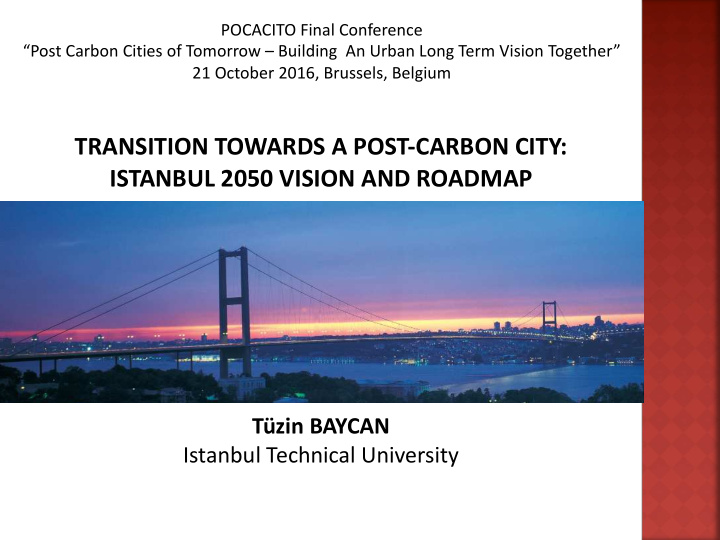



POCACITO Final Conference “Post Carbon Cities of Tomorrow – Building An Urban Long Term Vision Together” 21 October 2016, Brussels, Belgium TRANSITION TOWARDS A POST-CARBON CITY: ISTANBUL 2050 VISION AND ROADMAP Tüzin BAYCAN Istanbul Technical University
ISTANBUL
One of the most prestigious capitals of the ancient and modern world 8.500 years of history Capital of three empires: Roman, Byzantine and Ottoman
Istanbul is located in the heart of the world Two billion people live within a six-hour flight of Istanbul Istanbul is the world’s 5th global leading hub
The European Capital of Culture (2010) 9 th Cosmopolitan City in the World (The Ultimate Urban Guides, 2014) 14 th Global City in Night Life Attractions (Cities Journal, 2014) 11 th Global City in Europe (A.T.Kearney, 2014)
A dynamic modern metropolis with 14.4 million population Fastest growing destination city in Europe 12.6 million international visitors in 2015
ECONOMIC RESILIENCE $ 25 k $ 349 bn GDP per capita in Istanbul GDP of Istanbul Istanbul’s Economy > more than 130 countries
FOREIGN TRADE $ 218 bn foreign trade volume in Istanbul Istanbul’s foreign 70 thousand trade accounts almost half of Turkey’s total companies dealing with international trade in Istanbul
EXPANDING INFRASTRUCTURE
ISTANBUL: Key Performance Index Positive Trends ¡ Increase in social performance ¡ The advantage of being the economic center of Turkey, increase in economic performance Negative Trends ¡ Data collecting and access problems ¡ Urban sprawl ¡ Traffic jam and long travel time ¡ Population increase and migration ¡ Decrease of air quality ¡ Urbanisation pressure on natural protection areas
ISTANBUL 2050 Post-Carbon Vision ¡ VISION: ¢ 'A dynamic, innovative, self-sufficient, sustainable city having high level of life quality and good governance that able to compete at the global level’ ¡ CRITICAL SECTORS: quality of life governance environment and natural resources energy global competitiveness
TARGETS AND MILESTONES 2020: ¡ Reorganizing the transportation system and managing ¡ Expanding the public transportation network, implementation of planned railway system ¡ Generating a sustainable urban inventory and sharing with public (social, economic, environmental data) ¡ Creating a city information system ¡ Developing an energy master plan , increasing renewable energy resources and integrating them to the daily life ¡ Preparing an economic vision plan 2025: ¡ Consensus of stakeholders on valuable natural resources ¡ Determining of action plans and targets for energy master plan, developing framework for legal governmental regulations 2040: ¡ Planning for accessible city and implementing the plan
TARGETS AND MILESTONES 2050 TARGETS: Being among the top 10 in international quality of life indexes ¡ Decreasing the crime in the city to a minimum level ¡ Increasing the quality of inner and outer space ¡ Increasing coordination between central and local governments ¡ Participation of citizens in all processes ¡ Determining current problems ¡ Determining strategies focusing on solving problems ¡ Determining usable natural resources ¡ Integration of build and natural environment ¡ Protecting ecologically and biologically important areas ¡ Giving the status of 'protection forest' to all forest areas in Istanbul ¡ Sustainability in water supply and sewage management ¡ Renewable technology for natural resources usage, transportation, buildings and industry ¡ Energy efficient society - Zero CO2 emissions ¡ Efficient use of energy - electricity, water, gas - ¡ Unrivalled in global competition ¡
LESSONS LEARNED – CRITICAL ISSUES City Stakeholders: ¡ High participation rate, enthusiastic involvement, open to learn from other cities Representation: ¡ They did not represent their institutions but they participated as individual experts. ¡ Stakeholders’ statements do not mean any official response. ¡ They are not decision-makers. BUT, ¡ City stakeholders requested the results of the POCACITO Project in order to consider in their institutes’ strategic plans. Described Targets: ¡ City stakeholders had difficulties in thinking the long-term targets and milestones. ¡ They focussed mainly on the short-term targets. ¡ This short-term orientation also depends on the dynamics of the city and the uncertainties that they usually face. ¡ Istanbul is a primate city. Central government is very dominant and most of the cases the decision is taken from Ankara.
CRITICAL ISSUES FOR A LONG TERM VISION City size matters ¡ Megacities have at least 10 million population and managing megacities is more challenging ¡ Internal and international migration ¡ More people, more problems ¡ More megacities: more poverty, more disease, more inequality ¡ Unsuitable infrastructure (transport-logistics) for growth Efficiency comes with scale ¡ Less base infrastructure per person ¡ Net positives because of their densities Megacities are emerging economies ¡ 40% - 50% of the income of their countries ¡ Megacities determine the future of innovation
CRITICAL ISSUES FOR A LONG TERM VISION Future Estimations ¡ By 2030 the world will have 41 megacities ¡ 24 will be in Asia ¡ Two-thirds of their population will be poor Global urban culture is shifting EAST THE WAY FORWARD ¡ Transition from megacity towards global city
Thank you for your patience...
Recommend
More recommend